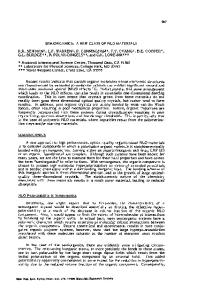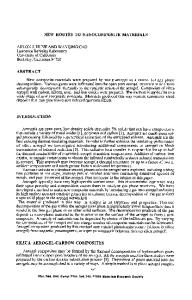Schwarzites to schwarzynes: A new class of superdeformable materials
- PDF / 859,366 Bytes
- 8 Pages / 432 x 648 pts Page_size
- 101 Downloads / 340 Views
MRS Advances © 2020 Materials Research Society DOI: 10.1557/adv.2020.298
Schwarzites to schwarzynes: A new class of superdeformable materials Eliezer Fernando Oliveira1,2,3 and Douglas Soares Galvao1,2 1
Gleb Wataghin Institute of Physics, University of Campinas (UNICAMP), Campinas, SP, Brazil. 2 Center for Computational Engineering & Sciences (CCES), University of Campinas (UNICAMP), Campinas, SP, Brazil. 3 Department of Materials Science and Nanoengineering, Rice University, Houston, TX, United States.
ABSTRACT
In this work, we have investigated the structural and mechanical properties of a new class of soft and superelastic materials, called schwarzynes. These materials are obtained by inserting sp carbon atoms (acetylenic groups) into the schwarzite framework. Using fully atomistic molecular dynamics simulations with the AIREBO force field, our results show that schwarzynes are stable materials up to high temperatures (1000K). Schwarzynes exhibit a very wide elastic regime, some of them up to 70% strain without structural fractures. Our preliminary results show that the elastic properties can be easily engineered by tuning the number of acetylenic groups and the crystallographic directions where they are inserted.
INTRODUCTION Carbon-based schwarzite structures proposed by Mackay and Terrones in 1991 [1], have attracted much attention due to their unusual mechanical and electronic properties. These stable structures have negative curvatures composed of sp2-like hybridized carbon atoms. Recent studies of atomistic and 3D printed models have shown that two different families of schwarzites, the so-called primitive and gyroid structures, can present distinct properties related to toughness and energy absorption [2,3]. In 1
Downloaded from https://www.cambridge.org/core. Cornell University Library, on 17 Sep 2020 at 06:18:34, subject to the Cambridge Core terms of use, available at https://www.cambridge.org/core/terms. https://doi.org/10.1557/adv.2020.298
general, when the amount of sp2 carbon atoms is increased (preserving the shape of the schwarzites), softer materials are obtained; thus, suggesting that the mechanical response of these materials can be engineered exploiting this feature. However, the effects of inserting sp or sp3-like carbon have not been investigated. In this work we have investigated the effects on the structural and mechanical properties when sp-like carbon atoms (acetylenic groups) are inserted into the framework of primitive schwarzites, creating in this way a new class of materials that we named schwarzynes. We used a similar approach in the sense that graphynes [4,5] are created from graphene parent structures by the insertion of acetylenic groups. We considered the P688 schwarzite as a study case (see Figure 1). We carried out fully atomistic molecular dynamics simulations to investigate the thermal stability and the mechanical behavior under compressive strains of the schwarzynes shown in Figure 1. Our results show that schwarzynes can outperform their schwarzite structural par
Data Loading...











